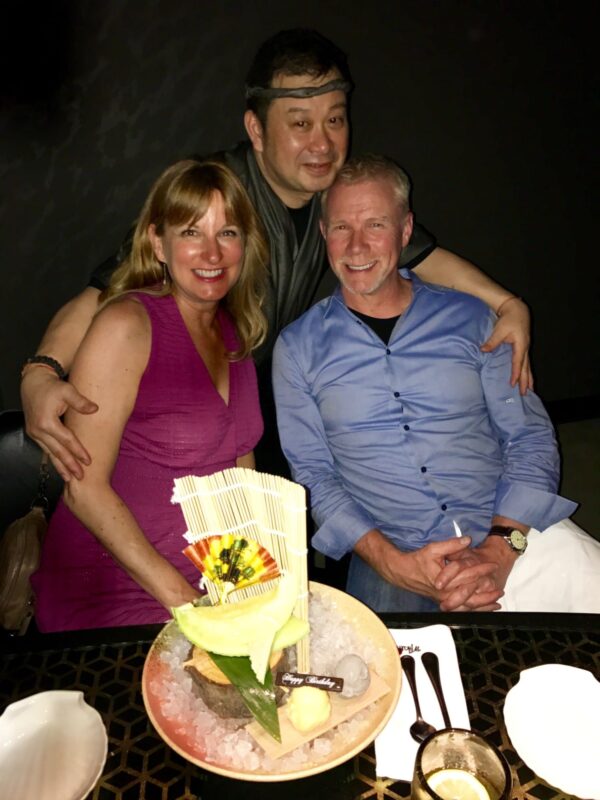Japanese muskmelons are the king of fruits, I learned towards the end of my birthday dinner in Singapore last month. My husband and I dined at the magnificent Mikuni in the Fairmont Singapore, sitting at the teppanyaki station under the friendly and watchful eye of Master Chef Eric.
Enlarge

Our meal started with a complimentary aperitif that was both sweet and refreshing. This was followed by a bit of soup served in small cups. For our entrees, we had chosen the melt-in-your-mouth tender wagyu beef teppanyaki and the lobster teppanyaki, served in its shell in a light creamy yellowish sauce. These were accompanied by a plate of sautéed veggies, and of course, a very fine sake that our waitress Victorine Lim recommended.
By the end of our meal we were fairly full, but Victorine insisted we have a birthday dessert and recommended the Japanese muskmelon. My husband wondered aloud to me why any melon slice would be worth SG$50. And the answer we soon found out.
Victorine and Chef Eric presented the slice of melon with sides of mango sorbet and black sesame sorbet in a very artful presentation as you can see by the featured photo at the top of this article. And then we got a lesson in Japanese muskmelons from the staff at Mikuni.
Enlarge

Jill L. Ferguson
How Japanese Muskmelons Are Grown
Japanese muskmelons are considered the king of fruits in their home country. They have commanded as much as $27,000 dollars at auction. They are tended to the way one tends to an infant--coddled, nurtured and protected from sunburn with small hats.
Muskmelons have a 100-day growth cycle, from planting to harvest. First, the best melon seeds are planted in soil bedding in glass greenhouses outfitted with both heating and air conditioning to ensure the melons stay warm but not too warm. (They are never planted in the ground.) The soil’s moisture—probably the single biggest factor determining a melon’s sweetness and flavor—must be fine-tuned to each plant’s growth, so the melons are monitored daily and watered as necessary as determined on a plant-by-plant basis.
When the vines flower, about twenty-five days after transplanting, the grower removes any scrawny, underdeveloped flowers and then quickly hand-pollinates each blossom using a small brush. After another ten days, when the fruit has grown to the size of an egg, the vines are pruned until each plant is left with just one melon, which is gently wrapped in thin paper to assure a perfectly colored, uniform surface. The culling channels all the nutrients and sugars into the one remaining melon, until it is literally bursting with flavor. (Or as our waitress said, "Many melons are sacrificed so a select few can be the best."
According to Slate.com, “These remaining muskmelons each get an outfit: a string tied around their stems to prevent them from falling as they ripen, plus their signature “hat”—black, cone-shaped—to prevent sunburn. As the melon grows, cracks develop in its exterior—think melon stretch marks, caused by insides expanding faster than the skin—and sugary juices flow into the cracks, creating elegant reticulation that makes it look as though the fruit has been caught in a khaki-colored net. (The finer the reticulation, the sweeter and juicier the melon, experts say.)”
Some growers don white gloves and give the melons frequent massages in an effort to make them sweeter (just like Japanese beef cattle are given massages to make their meat more tender and flavorful). Muskmelon farmers determine a melon’s ripeness from the degree of “give” at the bottom, the blossom end, and when the melon is gauged sweet enough and ripe, it is harvested and transported to a local cooperative where it is graded “on the basis of such factors as size, sugar content, and prominence of netting. Crown melons have six grades: Fuji at the top, followed by Yama, Shiro, Yuki, and so on. Only one melon in a thousand or so earns the top grade of Fuji,” according to Nippon.com
And like all fruit in Japan, each melon gets individually wrapped for protection, like works of fine art. Some are boxed and given as gifts. (Starting in the thirteenth century, samurai gave fruit gifts to their chiefs to show their loyalty and even today the gifting of fruit to bosses and loved ones is common in Japan-- the more expensive or exclusive the fruit, the bigger the statement/loyalty/affection.)
While I'm not sure what grade the Japanese muskmelon piece that we consumed at Mikuni was, I do know that it was the sweetest, most tender and fragrant melon I have ever had the pleasure of smelling and eating. The black sesame sorbet was the perfect savory and slightly salty accompaniment.
Fruit as a Reflection of Culture
Japanese muskmelons, to me, represent so much about Japanese culture, where luxury is prized, food is taken to new heights (through massage, attention to detail, culling and painstaking cultivation) and old traditions are combined with modern techniques and technology to bring humanity as close to perfection as possible.
I never expected a birthday celebration and trip to Singapore to bring me closer to Japanese culture, but I'm glad it did, and that the splurge on the muskmelon filled my heart with gratitude for fresh, flavorful, artfully presented food. I will never look again with an appetizing eye at the pale honeydew melons or the lumpy cantaloupes at my local United States markets. I will, however, look forward to returning to Tokyo and visiting Sembikiya, Japan's largest and oldest purveyor of luxury fruits, for the first time, or to returning to Chef Eric's table for more lobster teppanyaki and muskmelon.

